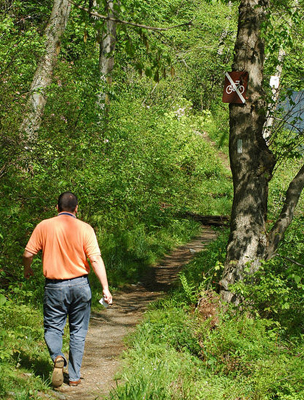Long-Distance Trails in Maryland
Maryland hosts portions of several inter-state long-distance trails.
 Launched in 1991, The East Coast Greenway is the nation's most ambitious
long-distance urban trail project. 3,000 miles long, the Greenway links Calais,
Maine at the Canadian border with Key West, Florida. Alternate routes will add
another 2,000 miles to the ECG trail system. The East Coast Greenway will be
entirely on public right-of-way, incorporating waterfront esplanades, park
paths, abandoned railroad corridors, canal towpaths, and pathways along highway
corridors.
Launched in 1991, The East Coast Greenway is the nation's most ambitious
long-distance urban trail project. 3,000 miles long, the Greenway links Calais,
Maine at the Canadian border with Key West, Florida. Alternate routes will add
another 2,000 miles to the ECG trail system. The East Coast Greenway will be
entirely on public right-of-way, incorporating waterfront esplanades, park
paths, abandoned railroad corridors, canal towpaths, and pathways along highway
corridors.
The route through Maryland connects colonial cities and towns with beautiful
rural landscapes, allowing the traveler to enjoy the countryside while keeping
urban amenities close at hand.
Entering Maryland from the north at Newark, Delaware, the route begins on
road in Elkton, then heads west to Perryville at the mouth of the Susquehanna
River. To cross the Susquehanna over the Hatem Bridge, travelers can take
advantage of Biller’s Bikes bridge
crossing services (at no charge for ECGA
members). Continuing
west beyond the Susquehanna, travelers cross rural Harford County to Monkton and
the first designated trail segment – the Torrey C. Brown Rail Trail. One more
on-road section and the route picks up the Jones Falls Trail into Baltimore. The
remainder of the route that links Baltimore with Annapolis and Washington, DC is
one of the most complete sections of Greenway. Shorter on-road sections link
together lengthy stretches of completed trail, making the going easier as the
population density increases.
The American Discovery Trail (ADT) is a new breed of national trail — part city,
part small town, part forest, part mountains, part desert — all in one trail.
Its 6,800+ miles of continuous, multi-use trail stretches from Cape Henlopen
State Park, Delaware, to Pt. Reyes National Seashore, California. It reaches
across America, linking community to community in the first coast to coast,
non-motorized trail.
The Great Eastern Trail Association, working with American Hiking Society and
local trail partners are creating America's newest long distance hiking trail.
This path is 1800 miles long and crosses nine states, from Alabama to New York!
The Great Allegheny Passage (GAP) rail-trail offers 135 miles of hiking and
biking between Cumberland, Maryland, and Duquesne, Pennsylvania, near
Pittsburgh. In Cumberland, the GAP joins the C&O Canal Towpath, creating a
continuous trail experience, 320 miles long, to Washington, DC.
The Maryland section of the GAP is a 22 mile rail trail that follows the
route of the former Western Maryland Railroad from Cumberland, Maryland to the
Pennsylvania line (Mason-Dixon Line). The GAP in Maryland parallels the Western
Maryland Scenic Railroad and its operational steam locomotive, which provides
scenic three-hour excursions to interested travelers. The trail is composed of
crushed limestone which is suitable for most bicycles. The trail elevation
increases 1625 feet over its course when riding south to north. This rise is a
moderate railroad grade of about 1.5%. There are no serious climbs, with two
tunnels and several bridges to take you through the mountains not over them. The
final few miles from Duquesne to Pittsburgh are still under construction and are
anticipated to be complete by September 11, 2011. Check the web site for trail
status www.gaptrail.org
The September 11th National Memorial Trail Alliance was formed in 2004 for
the sole purpose of establishing a memorial trail that will link the planned and
existing memorial sites at the World Trade Center, Pentagon and the Flight 93
National Memorial. The Alliance is a not-for-profit, 501 (c) 3 organization.
Contributions to the Alliance are tax deductible. In concept, the trail corridor
is approximately 1,000 miles long. The exact route is still being determined,
particularly for the section of trail stretching west from Shankesville,
Pennsylvania to New York City. The planning of the trail is based on the use of
existing trails and greenways wherever possible. The trail is shaped as a
triangle forever connecting together. The trail would start from the Pentagon in
Arlington, Virginia and connect with the Chesapeake and Ohio Canal National
Historical Park which follows the Potomac River from Georgetown in Washington,
D.C. through Maryland and West Virginia to Cumberland, Maryland; a distance of
184 miles. From Cumberland, the trail would follow the newly completed 150-mile
Great Allegheny Passage to Pittsburgh, Pennsylvania; both of these trails being
a segment of the planned Potomac Heritage National Scenic Trail. From
Pittsburgh the trail would move east to Shankesville, and then continue to New
York City. This leg would follow existing or new trails to be built, especially
taking advantage of Pennsylvania’s many rails-to-trails. The final leg from New
York City to the Pentagon would follow the East Coast Greenway; a greenway being
built for multi-use as the urban equivalent of the Appalachian Trail.